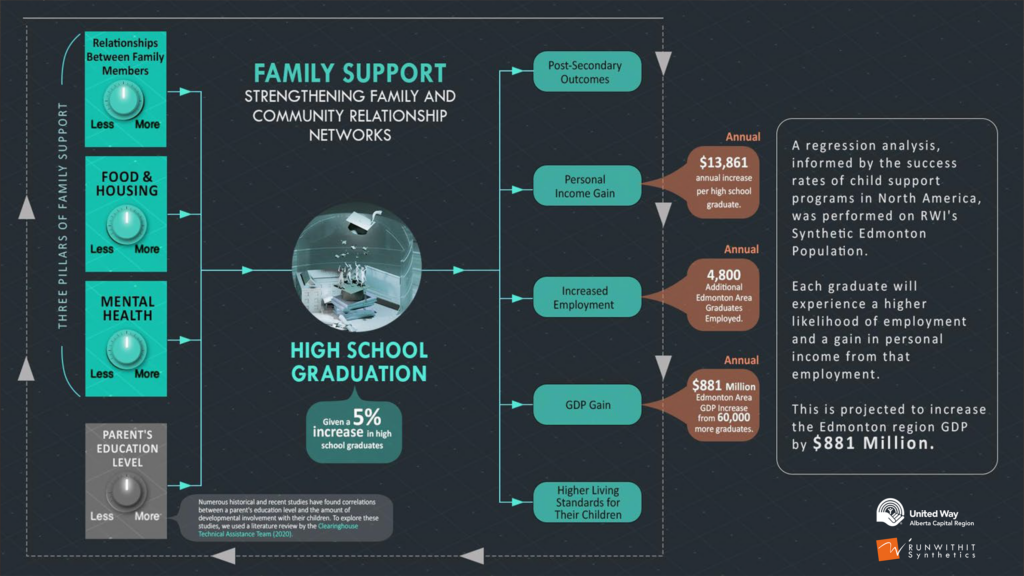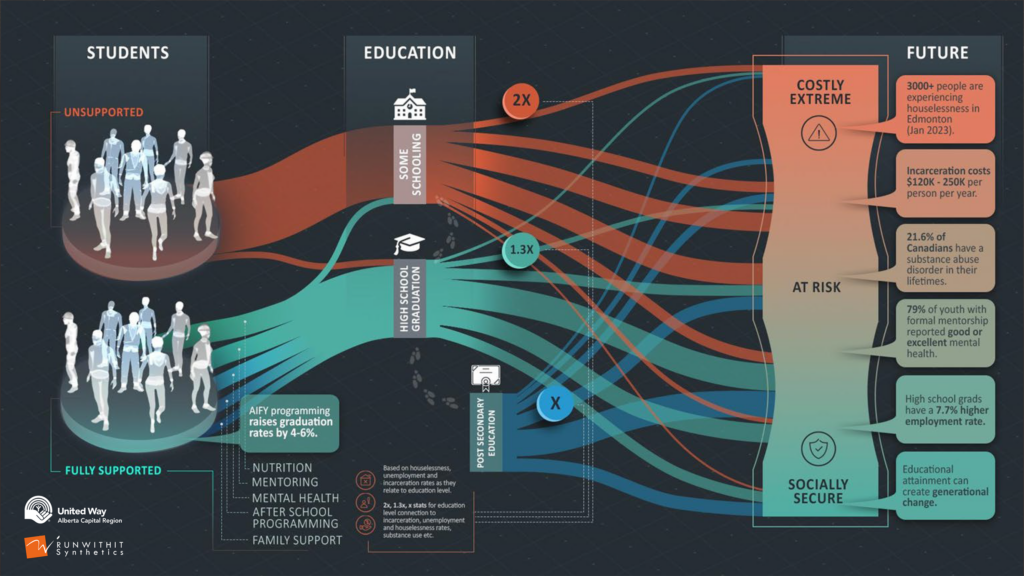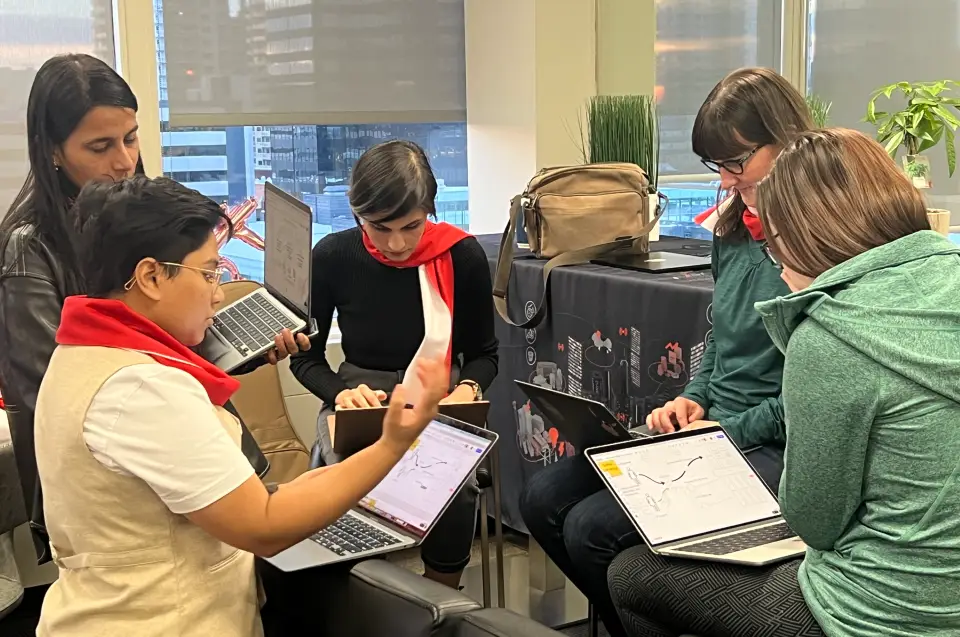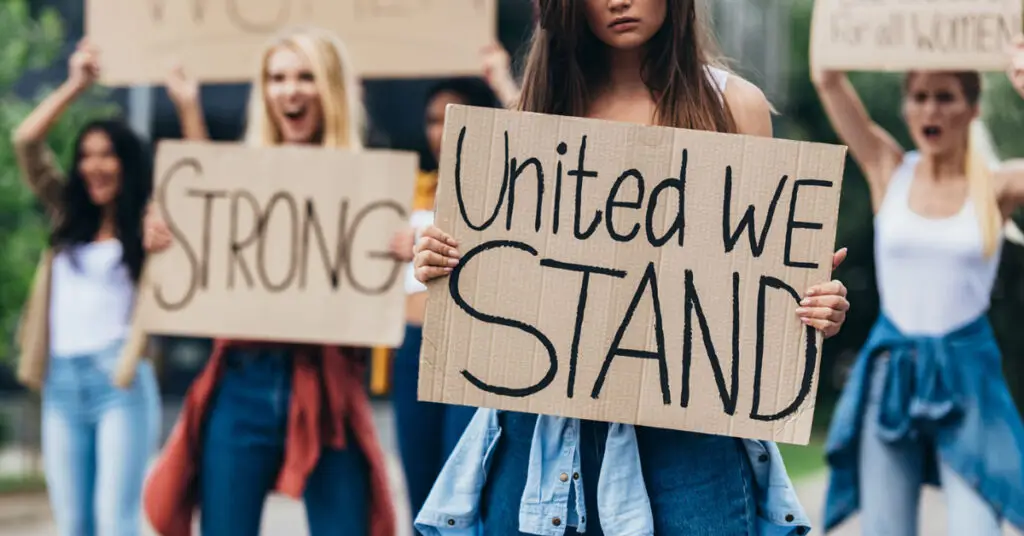March 20, 2023

Synthetic modelling hints that higher graduation rates could significantly grow employment and GDP in the Alberta Capital Region, and reduce strain on social sector
This is the second part in our series exploring how a synthetic modelling project by RUNWITHIT Synthetics can help United Way understand the potential future impact of our work in the community. Check out Part 1: Using AI to project the impacts of United Way’s work into the future.
Graduating high school isn’t just a major milestone in a student’s life. It’s key to bettering an individual’s chances of employment, increased lifetime earnings, higher standards of living – and for vulnerable students, breaking the cycle of poverty.
But making it to graduation day takes more than just good grades. Healthy relationships with family and friends, secure food and housing, and access to mental health resources are vital in supporting students on their journey to graduation.
There’s proof that investing in wraparound services today not only supports individuals in achieving more stable futures for themselves, but can also lead to cost-savings and economic benefits for the larger community in the future.
The price of poverty in Alberta is staggering: up to $9.5 billion is spent each year to treat the social symptoms that arise from people not having their needs met. This means that when we all invest in students to increase graduation rates, we’re also investing in breaking the cycle of poverty to create a stronger, more stable community and economy for everyone.
This is the premise behind All in for Youth (AIFY), United Way’s collaboration with other non-profits and funding partners that aims to improve graduation rates at some of the most vulnerable schools in Edmonton.
Currently implemented in eight schools, AIFY provides wrap-around services including nutrition, mentoring, family support, after-school programming, and mental health resources. Students and families from Kindergarten to Grade 12 can access these supports when and how they need them, right within the school.
By aggregating data from similar local programs and around the world, RUNWITHIT (RWI) Synthetics partnered with United Way to create a model of Edmonton in 2044 through the lens of AIFY’s goal – to increase graduation rates by five percent – to see if positive impacts might have a ripple effect throughout the region.
Spoiler alert: they do.
“While much of our work involves helping leaders in government, industry, and critical infrastructure design and invest in better futures, the future truly belongs to our youth. Supporting the incredible work of those in the AIFY programs making a difference in the lives of vulnerable youth and their families today and demonstrating their incredible impact in the community they will be a part of tomorrow, gives me hope,” shares Myrna Bittner, RWI Synthetics CEO and co-founder.
Here is what RWI discovered:

Infographic by RWI Synthetics
In RWI’s synthetic model, a five percentage point increase in the number of high school graduates would result in about 66,000 more Alberta Capital Region students finishing high school.
That increase in graduation could lead to 4,800 additional employed individuals in Edmonton, and an average of $13,861 higher annual income. In turn, the region’s GDP would also increase — those gainfully employed graduates could contribute $881 million more in GDP in the year 2044 alone. (In 2019, Edmonton’s GDP was about $91.57 billion CAD.)
And success in one generation impacts the next. Parents’ education levels strongly influence whether their children graduate, contributing to a positive generational feedback loop. With stability and continued educational achievement comes generational change and significant economic benefit.
Studies show that for every dollar invested in after-school programs, at least $3 is saved by increasing a youth’s earning potential. These programs help students improve their performance at school while also giving them a safe space to connect with trusted adults and peers. In turn, this reduces juvenile delinquency and crime.
Mentoring young people and supporting them to develop confidence and positive lifestyle habits leads to better academic performance, higher employment rates, and a higher likelihood to engage with their community. For every dollar invested, mentoring supports can return up to $23 to society.

Infographic by RWI Synthetics
Not only does investing in early supports like those provided by All in for Youth mean those students can contribute more to the economy, it can also have an impact on social spending down the road.
High school graduation isn’t a guarantee of a challenge-free life. On the flip side, not completing high school doesn’t necessarily mean that an individual will face challenges or poverty.
However, graduating high school reduces the chance that people will become part of the “costly extreme” — the segment of the population that experiences things like incarceration or houselessness, and often suffers more substantial medical consequences.
It often costs governments more to provide reactive support – for example, incarceration – than it does to provide preventive supports that reduce a person’s likelihood of committing crimes or otherwise interacting with the justice system.
Without acting to improve graduation rates by providing in-school supports, these costs — and the number of people needing support — could continue to rise.
All in for Youth has operated under the hypothesis that increasing graduation rates would have a positive economic and social impact on the Alberta Capital Region. The results of RWI Synthetic’s modelling are an exciting validation of the collaboration’s work so far, says Annette Malin, Portfolio Manager for Children and Youth at United Way.
“Being able to work with RWI Synthetics to tell this story in a new way is really exciting. This process has reinforced to me that we need more people to know about All in for Youth and the benefits of these supports,” Annette says. “It also provides us this different tool to talk about what could happen if we do nothing, or if we only keep doing what we are doing. I think there is such power in that, which we haven’t had access to prior to this experience.”

Thanks to synthetic modelling, we can better understand how wraparound supports in schools can help students, families, and the Edmonton community thrive in 2044.

Let’s dive into some of the compounding factors that women experiencing poverty face, and how programs supported by United Way addresses those barriers to level the playing field.

In 2022, as inflation exacerbated existing economic strain, causing increased needs for food access and security, higher energy costs, and decreased housing affordability, United Way’s 211 helpline became more vital than ever to connect people to the services they need.